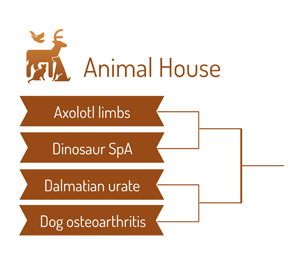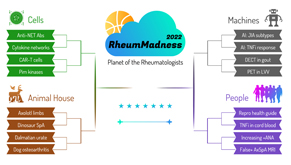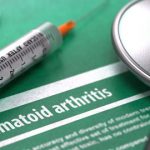 Editor’s note: RheumMadness is the place for everyone crazy about rheumatology to connect, collaborate, compete and learn together. During RheumMadness, rheumatology concepts represent teams that compete against each other in a tournament, much like basketball teams do in the NCAA’s March Madness tournament. In a series for The Rheumatologist, readers will get a chance to read the scouting reports for each concept team. These reports are written by rheumatology fellows from 13 programs throughout the U.S.
Editor’s note: RheumMadness is the place for everyone crazy about rheumatology to connect, collaborate, compete and learn together. During RheumMadness, rheumatology concepts represent teams that compete against each other in a tournament, much like basketball teams do in the NCAA’s March Madness tournament. In a series for The Rheumatologist, readers will get a chance to read the scouting reports for each concept team. These reports are written by rheumatology fellows from 13 programs throughout the U.S.
Don’t forget to submit your RheumMadness 2022 bracket by March 25. The more your picks match those of our Blue Ribbon Panel of rheumatologists, the more points you get. Learn more about the panel and how the brackets work online.
Connect with RheumMadness by subscribing to the podcast and joining the conversation on Twitter, #RheumMadness. Learn more on the RheumMadness website.
Region: Animal House Team: Axolotl Limbs
The axolotl is a water-based salamander named after Xolotl, the god of fire and lightning in ancient Aztec mythology. An important Mexican cultural symbol, the axolotl is recognized by its feather-like gills that resemble a headdress and its resting-smile face. The natural kawaiiness of the axolotl makes it a popular candidate for stuffed animals, and on the internet, it’s been compared with Kirby, the iconic Nintendo character. The species has even been featured in the videogame Minecraft and referenced in Frank Herbert’s renowned science fiction series Dune. Axolotls bred in captivity are common pets and often used in biomedical research. Unfortunately, the axolotl is critically endangered in the wild due to threats to its natural habitat, and the last surviving wild specimens can be found only in the lakes of Xochimilco, Mexico.1
 Axolotls have the ability to regenerate amputated limbs without scarring. Can the exact mechanisms for this ability be uncovered and applied to degenerative human diseases, such as osteoarthritis (OA)?
Axolotls have the ability to regenerate amputated limbs without scarring. Can the exact mechanisms for this ability be uncovered and applied to degenerative human diseases, such as osteoarthritis (OA)?
A fascinating 2019 Duke University study by Hsueh et al., published in Science Advances, found mature human cartilage in lower extremity joints has the ability to self-repair through a microRNA-mediated process that is also conserved in highly regenerative animals, such as zebrafish and the axolotl.2 In brief, these protective microRNA molecules were found to be more active in ankle joints than hip and knee joints. Moreover, the age of cartilage, which was determined by quantifying the extent of post-translational deamidation that spontaneously occurs in proteins with time (referred to as a molecular clock), was found to be youngest in ankles, older in knees and oldest in the hips. The microRNA data may explain why injuries to the ankle tend to heal more quickly than those affecting the hips and knees, and the deamidation data may explain why so few cases of severe ankle OA exist compared with hip and knee OA.
Implications
The management of OA is focused not on regeneration, but on symptoms. This approach can involve topical or oral nonsteroidal anti-inflammatory drugs (NSAIDs), physical therapy or eventually hip or knee joint replacement, if needed. However, this study uncovered a potentially new therapeutic target. Although more secrets certainly remain to be discovered about the underpinnings of human cartilage regeneration and axolotl biology, it’s exciting to ponder a distant—or not too distant—future in which gene therapy for OA is possible with the “injection of key regenerative [microRNA] in a joint, singly or in combination, could potentially enhance endogenous repair and resist degeneration of joint tissues in arthritis of all types, including after traumatic injury or insult.”2
Chances in the Tournament
We acknowledge the stiff competition from our furry, so-called, friends: limping dogs and gouty Dalmatians. Nevertheless, we are quite confident in the axolotl’s chances. Deep inside ourselves, we all have an inner axolotl ready to nourish our joints and help perform activities of daily living, such as walking, jumping and climbing stairs. And its full potential can be harnessed with more research and funding from the U.S. National Institutes of Health.
Last, can’t we all agree that axolotls are a lot more endearing than people, emotionless machines and the other non-smiling, faceless molecules in this year’s tournament?
Khiem Vu, MD, is a first-year rheumatology fellow in the Wake Forest School of Medicine Rheumatology Fellowship Program, Winston-Salem, N.C.
Alyssa Strazanac, MD, is a first-year rheumatology fellow in the Wake Forest School of Medicine Rheumatology Fellowship Program, Winston-Salem, N.C.
John Herion, DO, is a second-year rheumatology fellow in the Wake Forest School of Medicine Rheumatology Fellowship Program, Winston-Salem, N.C.
Rami Diab, MD, is a second-year rheumatology fellow in the Wake Forest School of Medicine Rheumatology Fellowship Program, Winston-Salem, N.C.
References
- Deines, T. Mexico City’s endangered axolotl has found fame—is that enough to save it? National Geographic. 2022 Jan 17.
- Hsueh MF, Önnerfjord P, Bolognesi MP, et al. Analysis of ‘old’ proteins unmasks dynamic gradient of cartilage turnover in human limbs. Sci Adv. 2019 Oct 9;5(10):eaax3203.
 Experience All of RheumMadness
Experience All of RheumMadness
During RheumMadness, rheumatology concepts represent teams that compete against each other in a tournament, much like basketball teams do in the NCAA’s March Madness tournament. In a series for The Rheumatologist, readers will get a chance to read the scouting reports. Check out the reports from each region:
Region: Cells
Region: Animal House
Region: Machines
Region: People
• False Positive MRI in Axial SpA
Don’t forget to submit your RheumMadness 2022 bracket by March 25. The winner of each match-up is decided by a seven-member Blue Ribbon Panel of rheumatologists. The panel will vote based on which topic they think is most important to patients, providers and researchers—both now and in the future. The more your picks match those of the panel, the more points you get. The tournament results will be released in four rounds from March 26–April 4. Prizes will be given to participants with the top scores in the following categories: 1) attending/APP, 2) fellow and 3) resident/medical student. The prize is a custom RheumMadness coffee mug and a lifetime of bragging rights.
Connect with RheumMadness by subscribing to the podcast and joining the conversation on Twitter, #RheumMadness. Learn on the RheumMadness website.



